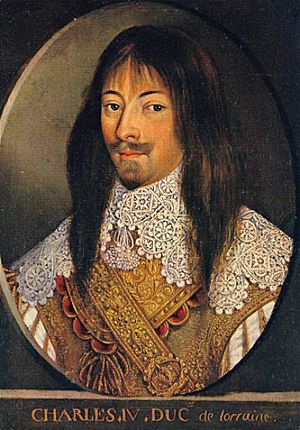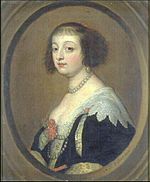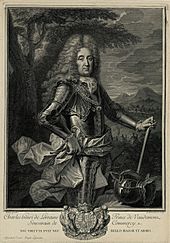Charles IV, Duke of Lorraine facts for kids
Quick facts for kids Charles IV |
|||||
|---|---|---|---|---|---|
 |
|||||
| Duke of Lorraine and Bar | |||||
| Reign | 1 December 1625 – 19 January 1634 | ||||
| Predecessor | Francis II | ||||
| Successor | Nicholas II | ||||
| Reign | 1 April 1634 – 18 September 1675 | ||||
| Predecessor | Nicholas II | ||||
| Successor | Charles V | ||||
| Born | 5 April 1604 Nancy |
||||
| Died | 18 September 1675 (aged 71) Allenbach |
||||
| Spouse | Nicolette of Lorraine Béatrice de Cusance Marie Louise d'Aspremont |
||||
| Issue | Anne, wife of François Marie de Lorraine Charles Henri, Prince of Vaudémont |
||||
|
|||||
| House | Lorraine | ||||
| Father | Francis II, Duke of Lorraine | ||||
| Mother | Christina of Salm | ||||
Charles IV (born April 5, 1604, in Nancy – died September 18, 1675, in Allenbach) was the Duke of Lorraine. He ruled from 1624 until his death in 1675. There was a short break in 1634 when he stepped down. This happened because of pressure from France. He gave up his title to his younger brother, Nicholas Francis.
Contents
Life of Charles IV, Duke of Lorraine
Charles IV faced many challenges during his rule. His lands, the Duchy of Lorraine, were located between powerful countries like France and the Holy Roman Empire. This made it a tricky place to govern.
Why Charles Lost His Duchy
Charles often disagreed with France's leaders. He supported Gaston d'Orléans, who was the French king's brother. Gaston often made plans against Cardinal Richelieu, who was a very powerful minister in France. Richelieu wanted to make France stronger. He often worked against the Habsburg family, who ruled the Holy Roman Empire.
Because Charles supported Gaston, French troops invaded Lorraine in 1633. Charles was forced to make difficult agreements with France. In 1634, he stepped down as Duke. He then joined the army of the Holy Roman Empire. This was during the Thirty Years' War, a big conflict in Europe. Charles even won a battle called the Battle of Nördlingen.
Fighting for His Home
After Charles left, his brother Nicholas Francis also had to flee. Charles then became Duke again, but he was in exile for many years. He kept trying to get his duchy back.
In 1635, Charles tried to recapture Lorraine with the Imperial army. But an outbreak of plague stopped their plans. The next year, Charles helped lift a French siege in Dole. He even advanced into French territory. For several years, he defended areas like Besançon and Dole against the French. He also made raids into France and Lorraine.
In 1638, Charles tried to relieve a siege at Breisach. But his forces were defeated. This made it harder for Lorraine to connect with the Holy Roman Empire. Charles then went to Brussels, hoping for a new military role.
Return and Later Battles
In 1641, Charles made a deal with France. He got his duchy back, but it became a French protectorate. This meant France had some control over it. However, Charles continued to work against Richelieu. He had to flee again in July 1641 to avoid arrest.
He then joined the Spanish army. He fought in battles in Flanders and later in the Holy Roman Empire. In 1643, he helped defeat the French at the Battle of Tuttlingen.
Help for Ireland?
In 1651, a group from Ireland asked Charles for help. They wanted his support against the English army that was invading Ireland. Some historians believe Charles was serious about helping Ireland. In 1652, his ships arrived with supplies at Inishbofin island, one of the last Irish strongholds. However, some Irish leaders did not trust him. Charles eventually decided that the Irish leaders' disagreements hurt their own cause.
Final Years and Legacy
In 1661, French troops left Lorraine. Charles was finally able to return home. But in 1670, France, under King Louis XIV, occupied the duchy again. Charles continued to serve in the Imperial armies. He fought in the Franco-Dutch War (1672–1678).
In 1675, Charles won a battle at Konzer Brucke. He died later that year while serving in the Austrian army. His family did not get the duchy back until more than twenty years after his death. Charles is sometimes called Charles III of Lorraine.
Family of Charles IV
Charles married Nicolette of Lorraine first. They did not have any children. Charles later left her.
On April 2, 1637, he married Béatrice de Cusance. She was a princess and had three children with Charles:
- Francis de Lorraine (1637–1638)
- Anne de Lorraine (1639–1720), who married her cousin François Marie de Lorraine.
- Charles Henri de Lorraine (1649–1723), who became Prince of Vaudémont.
Charles and Béatrice separated in 1642. More than 20 years later, on May 20, 1663, Charles married Béatrice de Cusance a second time. This was done to make sure their children were officially recognized. Béatrice died two weeks after this second marriage.
Charles married a fourth time to Countess Marie Louise of Aspremont-Lynden. They did not have any children.
See also
 In Spanish: Carlos IV de Lorena para niños
In Spanish: Carlos IV de Lorena para niños
Sources
- The Columbia Encyclopedia, Sixth Edition
- Michael O Siochru, God's Executioner: Oliver Cromwell and the Conquest of Ireland, Faber & Faber Ltd, London, 2008
| Preceded by Nicole |
Duke of Lorraine 1625–1634 |
Succeeded by Nicholas II |
| Preceded by Nicholas II |
Duke of Lorraine 1661–1675 |
Succeeded by Charles V |




